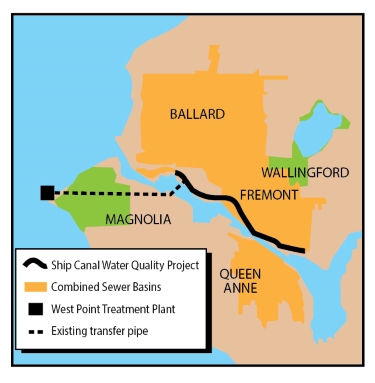|
Subscribe / Renew |
|
|
Contact Us |
|
| ► Subscribe to our Free Weekly Newsletter | |
| home | Welcome, sign in or click here to subscribe. | login |
Construction
| |
August 16, 2017
City, county to build giant tunnel for CSOs along the Ship Canal
Journal Construction Editor

Every year more than 60 million gallons of raw sewage and polluted stormwater flow into Lake Union, Salmon Bay and the Lake Washington Ship Canal.
These discharges, called combined sewer overflows or CSOs, come from surrounding neighborhoods and enter through seven aging outfall pipes.
There are more than 130 CSO discharges every year into those waters, and they typically are a mix of 10 percent sewage and 90 percent stormwater.
There is a federal mandate to reduce discharges to an average of one per year over a 20-year span, so the city of Seattle and King County will build a 2.7-mile storage tunnel just north of the Ship Canal. The tunnel is the main piece of a $450 million project to improve water quality in the three water bodies.
Overflows occur when heavy rain overwhelms the combined sewer systems, diverting some sewer waste and stormwater into the water bodies instead of conveying it to West Point Treatment Plant in Discovery Park.
The tunnel will store the overflows until West Point can process them.
The tunnel will be nearly 19 feet in diameter, and able to store about 29 million gallons of overflows from Ballard, Fremont, Wallingford and north Queen Anne. It will be 100 to 120 feet underground.
Keith Ward, Seattle Public Utilities' project executive for the program, said the original plan was for a 14-foot-diameter tunnel that could store 15 million gallons of CSOs. However, hydraulic modeling based on more recent rainfall data and climate change predictions convinced engineers to increase the tunnel diameter to 18 feet, 10 inches.
Ward said the storage volume will nearly double, but not the cost.
“If we're going to make it larger, now is the time to do it,” he said.
Ward said the CSO tunnel will be dug with a conventional tunnel boring machine, starting in Ballard and ending in Wallingford on a city-owned site near the North Transfer Station where there is an outfall pipe.
CSOs will flow into the ends of the tunnel, and surface water will drain into the tunnel through shafts at East Ballard and along the Ship Canal in Fremont.
Ward said they looked at building storage tanks at each of the seven outfall locations, but that would have been more expensive.
SPU earlier this year finished installing four underground tanks along Lake Washington to control CSOs between Seward and Magnuson parks. Those tanks range in size from 120,000 to 2.65 million gallons.
Ward said it was more cost-effective for King County, which operates two of the seven outfalls, to join the tunnel project. Another benefit with just one project is less impact on the community, he said.
The $450 million program will be built in phases under separate contracts.
First up is a contract for construction management, project support and commissioning that is budgeted at $17 million. Proposals for that are due Thursday. The contract will run through 2026 because the consultant will need to show that the system is in compliance at that time.
More information is in the July 13 notice in the DJC.
An estimated $9 million contract will bid later this year to prepare the Ballard launch site. Work will involve upgrades to the existing pier, soil remediation and extending utilities to the launch site. Ward said construction could start in spring 2018 and take a year to finish.
Next, an estimated $15 million contract will install pipe and do site work for a future pump station on the former Yankee Diner site in Ballard. It will be part of the Burke-Gilman Trail Missing Link project led by the Seattle Department of Transportation. Ward said construction could start in spring 2018 and take about a year to finish.
The main tunneling contract will begin in 2019 with the excavation of a shaft to lower the TBM. Tunneling will start in 2020 and take about 15 months. Ward estimates construction of the storage tunnel at $200 million.
Two conveyance lines will be built in Ballard and Wallingford from 2021 to 2023. Ward said those projects will likely be lumped together under a $25 million contract.
Other work will install a $28 million pump station by the pier in Ballard, from 2022 to 2024.
Ward said the entire system must be operating by the end of 2025 as part of the federal mandate. “You've got to be able to build it, but you've also got to be able to operate it,” he said.
Ward said SPU's goal is to complete the entire project up to a year early, which could be late 2024.
The storage tunnel will discharge into the county's North Interceptor pipe, which flows by gravity to West Point.
SPU is the lead agency and is funding about 65 percent of the overall project. King County's Department of Natural Resources and Parks is partnering with SPU and funding the balance.
The project will primarily be financed by bonds.
Benjamin Minnick can be
reached by email or by phone
at (206) 622-8272.


